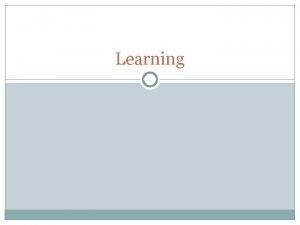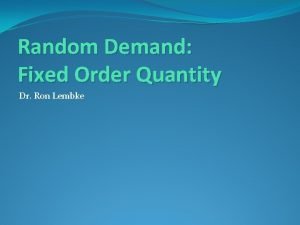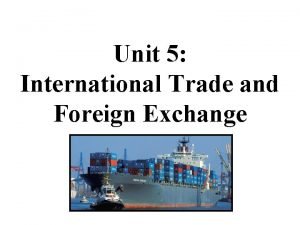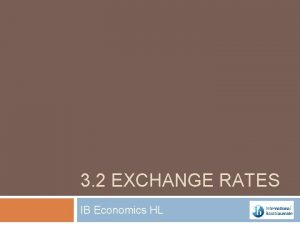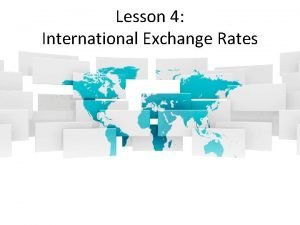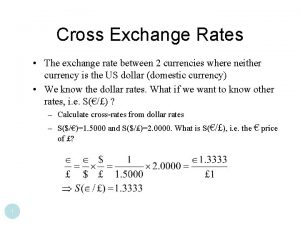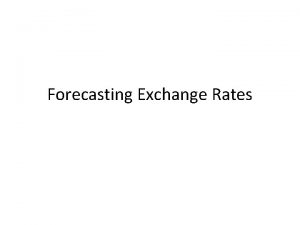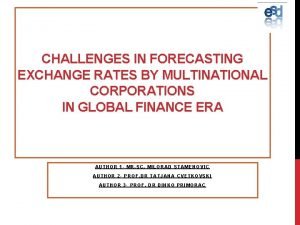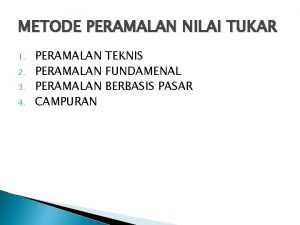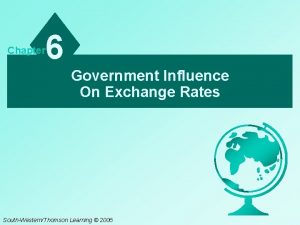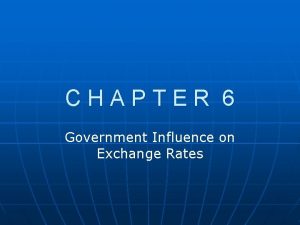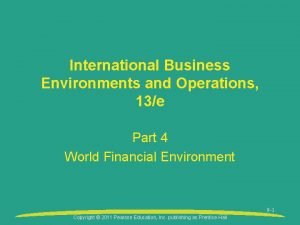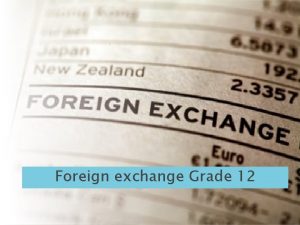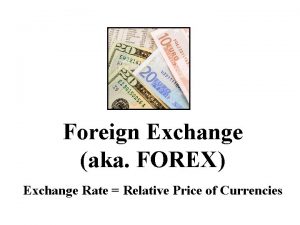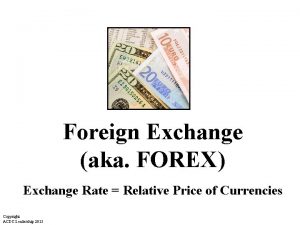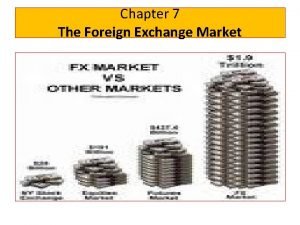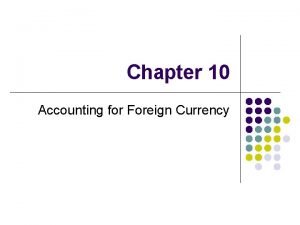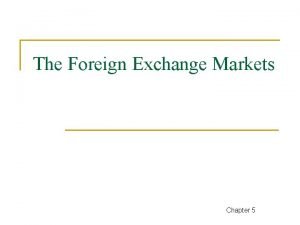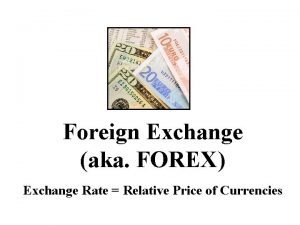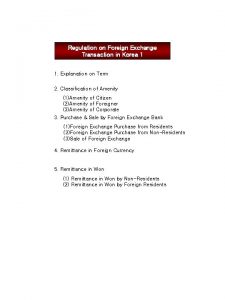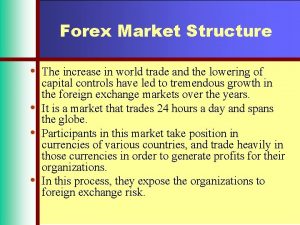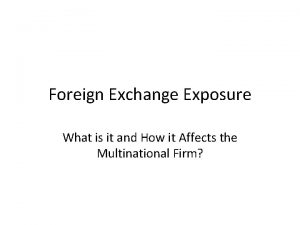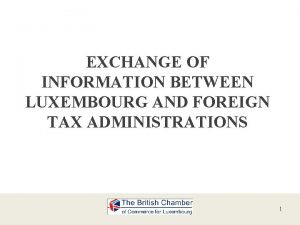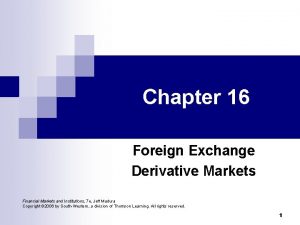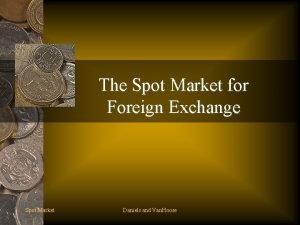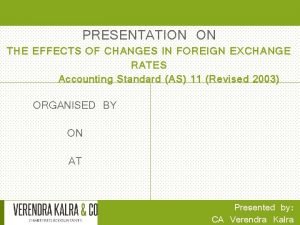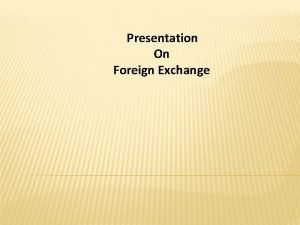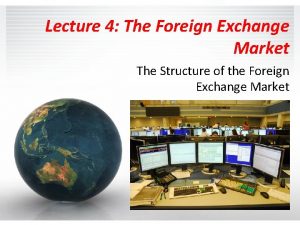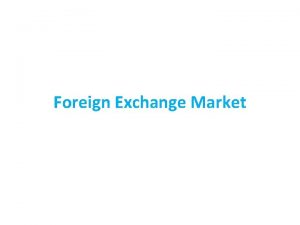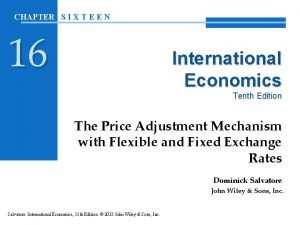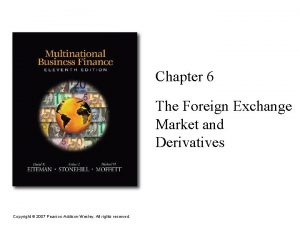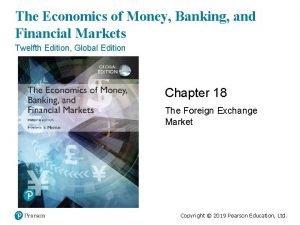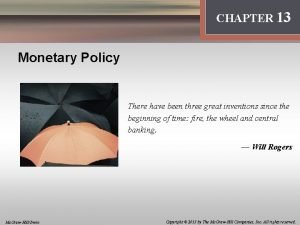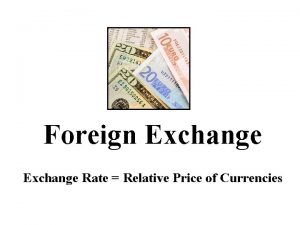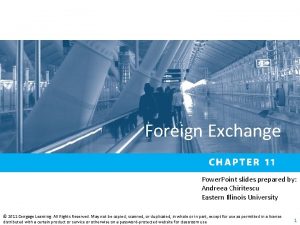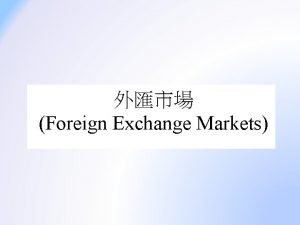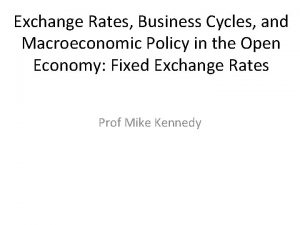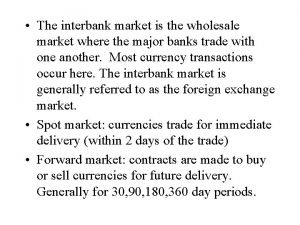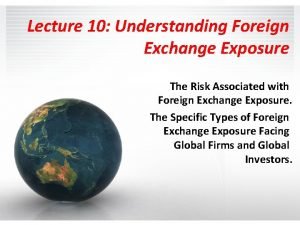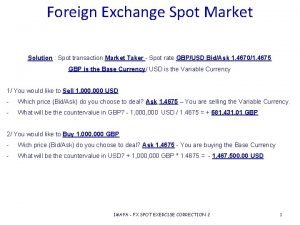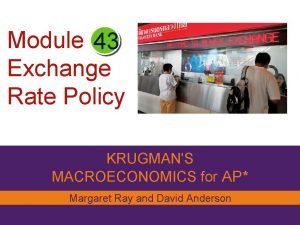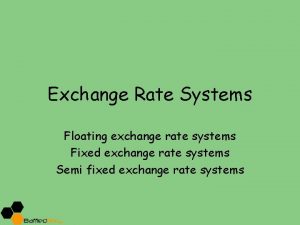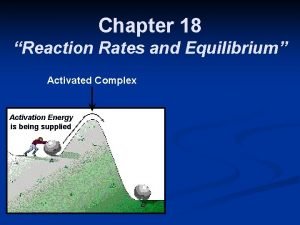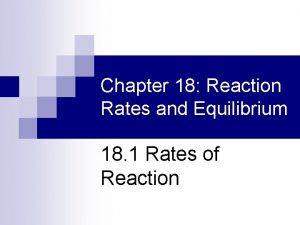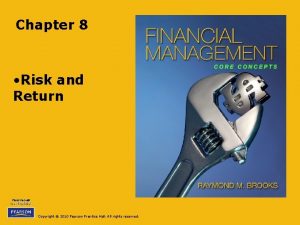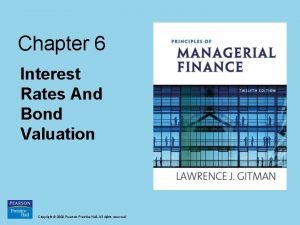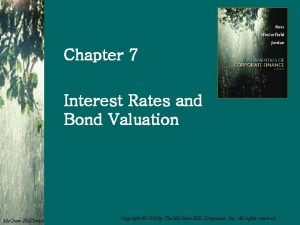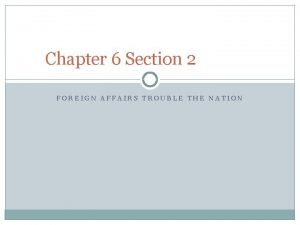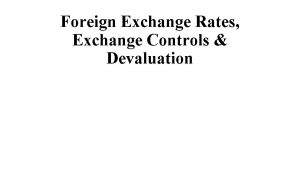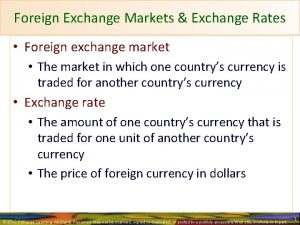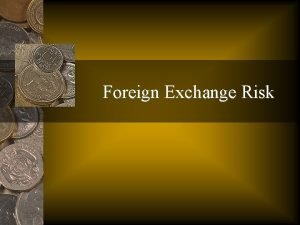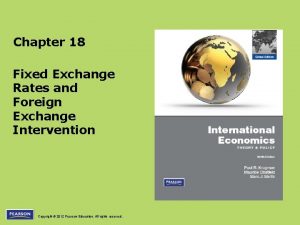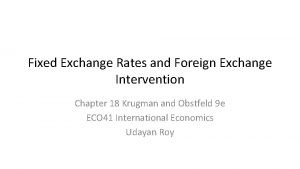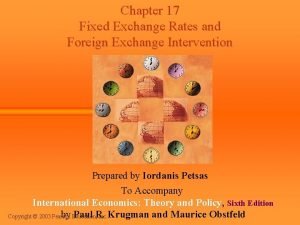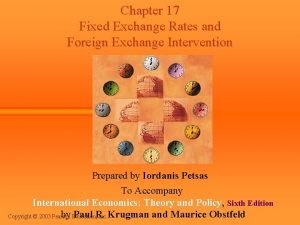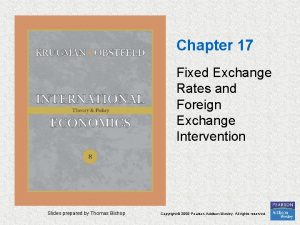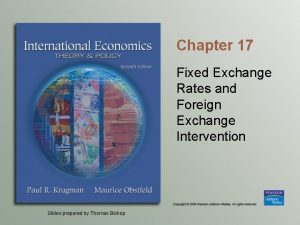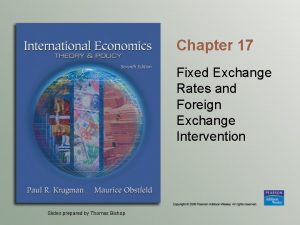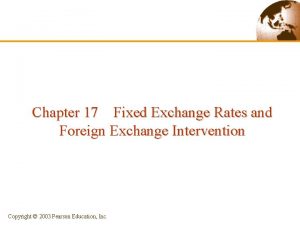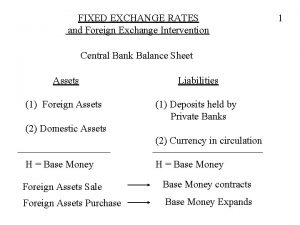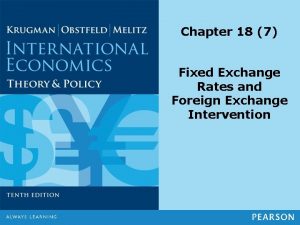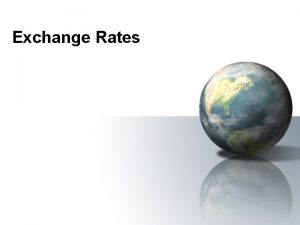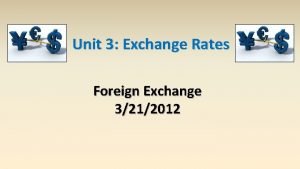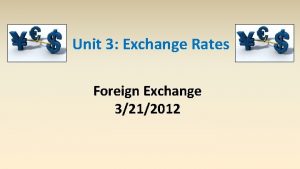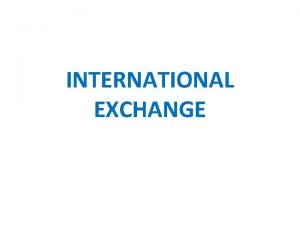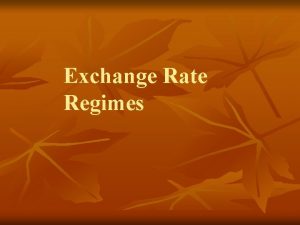Chapter 18 Fixed Exchange Rates and Foreign Exchange






































































- Slides: 70

Chapter 18 Fixed Exchange Rates and Foreign Exchange Intervention Copyright © 2012 Pearson Education. All rights reserved.

Preview • Balance sheets of central banks • Intervention in the foreign exchange markets and the money supply • How the central bank fixes the exchange rate • Monetary and fiscal policies under fixed exchange rates • Financial market crises and capital flight • Types of fixed exchange rates: reserve currency and gold standard systems Copyright © 2012 Pearson Education. All rights reserved. 18 -2

Introduction • Many countries try to fix or “peg” their exchange rate to a currency or group of currencies by intervening in the foreign exchange markets. • Many with a flexible or “floating” exchange rate in fact practice a managed floating exchange rate. – The central bank “manages” the exchange rate from time to time by buying and selling currency and assets, especially in periods of exchange rate volatility. • How do central banks intervene in the foreign exchange markets? Copyright © 2012 Pearson Education. All rights reserved. 18 -3

Central Bank Intervention and the Money Supply • To study the effects of central bank intervention in the foreign exchange markets, first construct a simplified balance sheet for the central bank. – This records the assets and liabilities of a central bank. – Balance sheets use double-entry bookkeeping: each transaction enters the balance sheet twice. Copyright © 2012 Pearson Education. All rights reserved. 18 -4

Central Bank’s Balance Sheet Assets Foreign Assets (official international reserves) n n n Foreign government bonds Foreign currency deposits Gold (official international reserves) n Domestic Assets n n n Domestic government bonds Loans to domestic banks Copyright © 2012 Pearson Education. All rights reserved. Liabilities n n Deposits of domestic banks Currency in circulation

Central Bank’s Balance Sheet (cont. ) • Assets = Liabilities + Net Worth – If we assume that net worth is constant, then • An increase in assets leads to an equal increase in liabilities. • A decrease in assets leads to an equal decrease in liabilities. • Changes in the central bank’s balance sheet lead to changes in currency in circulation or changes in deposits of banks, which lead to changes in the money supply. Copyright © 2012 Pearson Education. All rights reserved. 18 -6

Assets, Liabilities, and the Money Supply • A purchase of any asset by the central bank will be paid for with currency or a check written from the central bank, – both of which are denominated in domestic currency, and – both of which increase the supply of money in circulation. – The transaction leads to equal increases of assets and liabilities. • When the central bank buys domestic bonds or foreign bonds, the domestic money supply increases. Copyright © 2012 Pearson Education. All rights reserved. 18 -7

Assets, Liabilities, and the Money Supply (cont. ) • A sale of any asset by the central bank will be paid for with currency or a check written to the central bank, – both of which are denominated in domestic currency. – The central bank puts the currency into its vault or reduces the amount of deposits of banks, – causing the supply of money in circulation to shrink. – The transaction leads to equal decreases of assets and liabilities. • When the central bank sells domestic bonds or foreign bonds, the domestic money supply decreases. Copyright © 2012 Pearson Education. All rights reserved. 18 -8

Example: Copyright © 2012 Pearson Education. All rights reserved. 18 -9

Sterilization • Because buying and selling of foreign bonds in the foreign exchange markets affects the domestic money supply, a central bank may want to offset this effect. • This offsetting effect is called sterilization. • If the central bank sells foreign bonds in the foreign exchange markets (reduce the money supply), it can buy domestic government bonds in bond markets (increase the money supply)—hoping to leave the amount of money in circulation unchanged. Copyright © 2012 Pearson Education. All rights reserved. 18 -10

Table 18 -1: Effects of a $100 Foreign Exchange Intervention: Summary Copyright © 2012 Pearson Education. All rights reserved. 18 -11

Fixed Exchange Rates • To fix the exchange rate, a central bank influences the quantities supplied and demanded of currency by trading domestic and foreign assets, so that the exchange rate (the price of foreign currency in terms of domestic currency) stays constant. • Foreign exchange markets are in equilibrium when R = R* + (Ee – E)/E • When the exchange rate is fixed at some level E 0 and the market expects it to stay fixed at that level, then R = R* Copyright © 2012 Pearson Education. All rights reserved. 18 -12

Fixed Exchange Rates (cont. ) • To fix the exchange rate, the central bank must trade foreign and domestic assets in the foreign exchange market until R = R*. • Alternatively, we can say that it adjusts the quantity of monetary assets in the money market until the domestic interest rate equals the foreign interest rate, given the level of average prices and real output: Ms/P = L(R*, Y) Copyright © 2012 Pearson Education. All rights reserved. 18 -13

Fixed Exchange Rates (cont. ) • Suppose that the central bank has fixed the exchange rate at E 0 but the level of output rises, raising the demand of real monetary assets. • This is predicted to put upward pressure on interest rates and the value of the domestic currency. • How should the central bank respond if it wants to fix exchange rates? Copyright © 2012 Pearson Education. All rights reserved. 18 -14

Fig. 18 -1: Asset Market Equilibrium with a Fixed Exchange Rate, E 0 Copyright © 2012 Pearson Education. All rights reserved. 18 -15

Fixed Exchange Rates (cont. ) • The central bank should buy foreign assets in the foreign exchange markets, – thereby increasing the domestic money supply, – thereby reducing interest rates in the short run. – Alternatively, by demanding (buying) assets denominated in foreign currency and by supplying (selling) domestic currency, the price/value of foreign currency is increased and the price/value of domestic currency is decreased. Copyright © 2012 Pearson Education. All rights reserved. 18 -16

Stabilization Policies with a Fixed Exchange Rate • Monetary policy • Fiscal policy • An abrupt change in exchange rate’s fixed level, E 0 • Analysis approaches – DD-AA model – Assumption: the expected future exchange rate Ee equals the fixed rate E 0 Copyright © 2012 Pearson Education. All rights reserved.

Monetary Policy and Fixed Exchange Rates • When the central bank buys and sells foreign assets to keep the exchange rate fixed and to maintain domestic interest rates equal to foreign interest rates, it is not able to adjust domestic interest rates to attain other goals, i. e. , monetary policy is not independent. – In particular, monetary policy is ineffective in influencing output and employment. Copyright © 2012 Pearson Education. All rights reserved. 18 -18

Fig. 18 -2: Monetary Expansion Is Ineffective Under a Fixed Exchange Rate Copyright © 2012 Pearson Education. All rights reserved. 18 -19

Fiscal Policy and Fixed Exchange Rates in the Short Run • Changes in fiscal policy are more effective in influencing output and employment in the short run: – The rise in aggregate demand output due to expansionary fiscal policy raises demand for real monetary assets, putting upward pressure on interest rates and on the value of the domestic currency. – To prevent an appreciation of the domestic currency, the central bank must buy foreign assets, thereby increasing the money supply and decreasing interest rates. Copyright © 2012 Pearson Education. All rights reserved. 18 -20

Fig. 18 -3: Fiscal Expansion Under a Fixed Exchange Rate A fiscal expansion increases aggregate demand Increase in Y under fixed exchange rate is greater that under floating rate. Thus, fiscal policy is very powerful under fixed exchange rate system. Copyright © 2012 Pearson Education. All rights reserved. To prevent the domestic currency from appreciating, the central bank buys foreign assets, increasing the money supply and decreasing interest rates.

Fiscal Policy and Fixed Exchange Rates in the Long Run • When the exchange rate is fixed, there is no real appreciation of the value of domestic products in the short run: q=EP*/P. • But when output is above its potential level, wages and prices tend to rise in the long run. • A rising price level makes domestic products more expensive: a real appreciation (EP*/P falls). – Aggregate demand output decrease as prices rise: DD curve shifts left. – Prices tend to rise until employment, aggregate demand, and output fall to their normal (potential or natural) levels. Copyright © 2012 Pearson Education. All rights reserved. 18 -22

Fiscal Policy and Fixed Exchange Rates in the Long Run (cont. ) • Prices are predicted to change proportionally to the change in the money supply when the central bank intervenes in the foreign exchange markets. – AA curve shifts down (left) as prices rise. – Nominal exchange rates will be constant (as long as the fixed exchange rate is maintained), but the real exchange rate will be lower (a real appreciation). Copyright © 2012 Pearson Education. All rights reserved. 18 -23

Devaluation and Revaluation • Depreciation and appreciation refer to changes in the value of a currency due to market changes. • Devaluation and revaluation refer to changes in a fixed exchange rate caused by the central bank. – With devaluation, a unit of domestic currency is made less valuable, so that more units must be exchanged for 1 unit of foreign currency. – With revaluation, a unit of domestic currency is made more valuable, so that fewer units need to be exchanged for 1 unit of foreign currency. Copyright © 2012 Pearson Education. All rights reserved. 18 -24

Fig. 18 -4: Effect of a Currency Devaluation If the central bank devalues the domestic currency so that the new fixed exchange rate is E 1, it buys foreign assets, increasing the money supply, decreasing the interest rate and increasing output Copyright © 2012 Pearson Education. All rights reserved.

Devaluation • It causes: – A rise in output – A rise in official reserves – An expansion of the money supply • It is chosen by governments to: – Fight domestic unemployment – Improve the current account – Affect the central bank's foreign reserves Copyright © 2012 Pearson Education. All rights reserved.

Financial Crises and Capital Flight • When a central bank does not have enough official international reserve assets to maintain a fixed exchange rate, a balance of payments crisis results. – To sustain a fixed exchange rate, the central bank must have enough foreign assets to sell in order to satisfy the demand of them at the fixed exchange rate. Copyright © 2012 Pearson Education. All rights reserved. 18 -27

Financial Crises and Capital Flight (cont’d) • The market’s belief in an impending change in the exchange rate gives rise to a balance of payments crisis, a sharp change in official foreign exchange reserves sparked by a change in expectations about the future exchange rate. Copyright © 2012 Pearson Education. All rights reserved.

Financial Crises and Capital Flight (cont. ) • Investors may expect that the domestic currency will be devalued, causing them to want foreign assets instead of domestic assets, whose value is expected to fall soon. 1. This expectation or fear only makes the balance of payments crisis worse: – Investors rush to change their domestic assets into foreign assets, depleting the stock of official international reserve assets more quickly. Copyright © 2012 Pearson Education. All rights reserved. 18 -29

Financial Crises and Capital Flight (cont. ) 2. As a result, financial capital is quickly moved from domestic assets to foreign assets: capital flight. – 3. To avoid this outcome, domestic assets must offer high interest rates to entice investors to hold them. – 4. The domestic economy has a shortage of financial capital for investment and has low aggregate demand. The central bank can push interest rates higher by reducing the money supply (by selling foreign and domestic assets). As a result, the domestic economy may face high interest rates, a reduced money supply, low aggregate demand, low output, and low employment. Copyright © 2012 Pearson Education. All rights reserved. 18 -30

Fig. 18 -5: Capital Flight, the Money Supply, and the Interest Rate Expected devaluation makes the expected return on foreign assets higher The expectation of future devaluation causes a BOP crisis marked by a sharp fall in reserves and a rise in the home interest rate above the world interest rate and vice versa. Copyright © 2012 Pearson Education. All rights reserved. To attract investors to hold domestic assets (currency) at the original exchange rate, the interest rate must rise through a sale of foreign assets.

Financial Crises and Capital Flight (cont. ) • Expectations of a balance of payments crisis only worsen the crisis and hasten devaluation. – What causes expectations to change? • Expectations about the central bank’s ability and willingness to maintain the fixed exchange rate. • Expectations about the economy: shrinking demand of domestic products relative to foreign products means that the domestic currency should become less valuable. • In fact, expectations of devaluation cause a devaluation: a self-fulfilling crisis. Copyright © 2012 Pearson Education. All rights reserved. 18 -32

Financial Crises and Capital Flight (cont. ) • What happens if the central bank runs out of official international reserve assets (foreign assets)? • It must devalue the domestic currency so that it takes more domestic currency (assets) to exchange for 1 unit of foreign currency (asset). – increasing the money supply, – reducing interest rates, – reducing the value of domestic products, – increasing aggregate demand, output, and employment over time. Copyright © 2012 Pearson Education. All rights reserved. 18 -33

Fig. 18 -7: Growth Rates of International Reserves Source: Economic Report of the President, 2010. Copyright © 2012 Pearson Education. All rights reserved. 18 -34

Managed Floating and Sterilized Intervention • Under managed floating, monetary policy is influenced by exchange rate changes without being completely subordinate to the requirements of a fixed rate. • The central bank faces a trade-off between domestic objectives (employment or the inflation rate) and exchange rate stability. Copyright © 2012 Pearson Education. All rights reserved.

Perfect asset substitutability & Ineffectiveness of sterilized intervention • Without change in the domestic money supply, any intervention by the central bank will not affect the domestic interest rate and therefore will not affect the exchange rate. • The ineffectiveness of monetary policy under a fixed exchange rate implies that sterilization is a self-defeating policy. Copyright © 2012 Pearson Education. All rights reserved.

Perfect Asset Substitutability • Key assumption is: domestic assets and foreign assets are perfect substitutes. – People only care about the expected rate of returns. – Interest rate parity condition holds. Copyright © 2012 Pearson Education. All rights reserved.

Interest Rate Differentials • For many countries, the expected rates of return are not the same: R > R*+(Ee –E)/E. Why? • Default risk: The risk that the country’s borrowers will default on their loan repayments. Lenders therefore require a higher interest rate to compensate for this risk. • Exchange rate risk: If there is a risk that a country’s currency will depreciate or be devalued, then domestic borrowers must pay a higher interest rate to compensate foreign lenders. Copyright © 2012 Pearson Education. All rights reserved. 18 -38

Interest Rate Differentials (cont. ) • Because of these risks, domestic assets and foreign assets are not treated the same. – Previously, we assumed that foreign and domestic currency deposits were perfect substitutes: deposits everywhere were treated as the same type of investment, because risk and liquidity of the assets were assumed to be the same. – In general, foreign and domestic assets may differ in the amount of risk that they carry: they may be imperfect substitutes. – Investors consider these risks, as well as rates of return on the assets, when deciding whether to invest. Copyright © 2012 Pearson Education. All rights reserved. 18 -39

Interest Rate Differentials (cont. ) • A difference in the risk of domestic and foreign assets is one reason why expected rates of return are not equal across countries: R = R*+(Ee –E)/E + where is called a risk premium, an additional amount needed to compensate investors for investing in risky domestic assets. • The risk could be caused by default risk or exchange rate risk. Copyright © 2012 Pearson Education. All rights reserved. 18 -40

Interest Rate Differentials (cont. ) Exchange rate, E E 2 2’ 1’ E 1 R*+(Ee-E)/E+ 2 R*+(Ee-E)/E+ With imperfect substitutability, even sterilized purchases of foreign exchange cause the home currency to depreciate. Similarly, sterilized sales of foreign exchange cause the home currency to appreciate. M/P Copyright © 2012 Pearson Education. All rights reserved. 1 Domestic interest rate, R R 1 1 L(R, Y) Real money supply

Fig. 18 -6: Effect of a Sterilized Central Bank Purchase of Foreign Assets Under Imperfect Asset Substitutability Copyright © 2012 Pearson Education. All rights reserved. 18 -42

CASE STUDY: The Mexican Peso Crisis, 1994– 1995 Source: Saint Louis Federal Reserve Copyright © 2012 Pearson Education. All rights reserved.

CASE STUDY: The Mexican Peso Crisis, 1994– 1995 • In the early 1990 s, Mexico was an attractive place foreign investment. • During 1994, political shocks caused an increase in Mexico’s risk premium ( ) due to increases in default risk and exchange rate risk: – rebellion and political unrest in Chiapas – assassination of leading presidential candidate • Also, the Federal Reserve System raised U. S. interest rates during 1994 to prevent U. S. inflation. (So, R* ↑ ) Copyright © 2012 Pearson Education. All rights reserved.

CASE STUDY: The Mexican Peso Crisis, 1994– 1995 • These events put downward pressure on the value of the peso. • Mexico’s central bank had promised to maintain the fixed exchange rate. • To do so, it sold dollar denominated assets, decreasing the money supply and increasing interest rates. • To do so, it needed to have adequate reserves of dollar denominated assets. Did it? Copyright © 2012 Pearson Education. All rights reserved.

U. S. Dollar Denominated International Reserves at the Mexican Central Bank January 1994 ……………… $27 billion October 1994 …………………$17 billion November 1994 ………. . …… $13 billion December 1994 ………. . …… $ 6 billion During 1994, Mexico’s central bank hid the fact that its reserves were being depleted. Why? Source: Banco de México, http: //www. banxico. org. mx Copyright © 2012 Pearson Education. All rights reserved.

CASE STUDY: The Mexican Peso Crisis, 1994– 1995 • 20 Dec 1994: Mexico devalues the peso by 13%. It fixes E at 4. 0 pesos/dollar instead of 3. 4 pesos/dollar. • Investors expect that the central bank has depleted its reserves. • ↑ further due to exchange rate risk: investors expect the central bank to devalue again and they sell Mexican assets, putting more downward pressure on the value of the peso. • 22 Dec 1994: with reserves nearly gone, the central bank abandons the fixed rate. • In a week, the peso falls another 30% to about 5. 7 pesos/dollar. Copyright © 2012 Pearson Education. All rights reserved.

The Rescue Package: Reducing • The U. S. & IMF set up a $50 billion fund to guarantee the value of loans made to Mexico’s government, – reducing default risk, – and reducing exchange rate risk, since foreign loans could act as official international reserves to stabilize the exchange rate if necessary. • After a recession in 1995, the economy began to recover. – Mexican goods were relatively inexpensive, allowing production to increase. – Increased demand of Mexican products relative to demand of foreign products stabilized the value of the peso and reduced exchange rate risk. Copyright © 2012 Pearson Education. All rights reserved. 18 -48

1997 Asian Financial Crisis • The Asian financial crisis was a period of financial crisis that gripped much of East Asia and Southeast Asia beginning in July 1997 and raised fears of a worldwide economic meltdown due to financial contagion. Copyright © 2012 Pearson Education. All rights reserved. 18 -49

1997 Asian Financial Crisis • From 1985 -1996, Thailand's economy grew at 9% per year. The Thai baht was pegged at 25 to the U. S. dollar. • The economy boom and credit expansion in Thailand makes the economy borrow huge foreign debt (denominated in US dollar). • Some trigger factors: (1) US raised interest rate, US dollar appreciated; (2) Financial account liberalization in Thailand attracted huge hot money, caused large bubbles in asset markets; (3) attacked by currency speculators (Soros). • Weak economic fundamental + limited foreign reserve force Thailand government to float Thai baht, resulting in a collapse in exchange rate. • Real consequences of currency crisis: credit crunch, weak market sentiment, high interest rates, stock market collapse… Copyright © 2012 Pearson Education. All rights reserved. 18 -50

Exchange rate of Thai Baht Copyright © 2012 Pearson Education. All rights reserved. 18 -51

Hong Kong Monetary System • Since 1983, the linked exchange rate system (LERS) is used for the Hong Kong dollar to be pegged with the US dollar at a fixed rate of 7. 80. • In this unique LERS, the Hong Kong Monetary Authority (HKMA) authorises the three note-issuing banks (HSBC, Bank of China and Standard Chartered) to issue new banknotes provided that they deposit an equivalent value of United States dollars with the HKMA. • By this arrangement, the Hong Kong dollar is backed by one of the world's largest foreign exchange reserves, which is over 7 times the amount of money supplied in circulation or about 48% of Hong Kong dollar M 3 at the end of April 2016. Copyright © 2012 Pearson Education. All rights reserved. 18 -52

Hong Kong Monetary System • In practice, the exchange rate of 7. 80, is strictly controlled by the HKMA in the foreign exchange market by controlling supply and demand of Hong Kong dollars in order to influence the exchange rate being fixed. • When the market rate is below 7. 80, the banks will convert US for Hong Kong dollars from the HKMA, Hong Kong dollars supply will increase, and the market rate will climb back to 7. 80. Copyright © 2012 Pearson Education. All rights reserved. 18 -53

How Does HKMA Control the Rate? investors sell HK dollar Capital outflow depreciation pressure HKMA buy HK dollar Money base declines Interest rate increases Investors buy more or sell less Stabilize EX rate Copyright © 2012 Pearson Education. All rights reserved. 18 -54

HK Dollar in Asian Financial Crisis Copyright © 2012 Pearson Education. All rights reserved. 18 -55

But Stock Market in HK Suffers Copyright © 2012 Pearson Education. All rights reserved. 18 -56

Types of Fixed Exchange Rate Systems 1. Reserve currency system: one currency acts as official international reserves. – The U. S. dollar was the currency that acted as official international reserves from under the fixed exchange rate system from 1944 to 1973. – All countries except the U. S. held U. S. dollars as the means to make official international payments. 2. Gold standard: gold acts as official international reserves that all countries use to make official international payments. Copyright © 2012 Pearson Education. All rights reserved. 18 -57

Reserve Currency System • From 1944 to 1973, central banks throughout the world fixed the value of their currencies relative to the U. S. dollar by buying or selling domestic assets in exchange for dollar denominated assets. • Arbitrage ensured that exchange rates between any two currencies remained fixed. – Suppose Bank of Japan fixed the exchange rate at 360¥/US$1 and the Bank of France fixed the exchange rate at 5 Ffr/US$1. – The yen/franc rate was (360¥/US$1)/(5 Ffr/US$1) = 72¥/1 Ffr. – If yen/franc=60¥/1 Ffr in the market, then there is arbitrage: sell $1 to Bo. J and obtain 360¥ -> sell 360¥ in the market to obtain 6 Ffr->sell 6 Ffr to Bo. F and obtain $1. 2. In sum, gain profit $0. 2. Copyright © 2012 Pearson Education. All rights reserved. 18 -58

Reserve Currency System (cont. ) • Because most countries maintained fixed exchange rates by trading dollar-denominated (foreign) assets, they had ineffective monetary policies (see the previous analysis). • The Federal Reserve, however, did not have to intervene in foreign exchange markets, so it could conduct monetary policy to influence aggregate demand, output, and employment. – The U. S. was in a privileged position because it was able to use monetary policy as it wished. Copyright © 2012 Pearson Education. All rights reserved. 18 -59

Reserve Currency System (cont. ) • In fact, the monetary policy of the U. S. influenced the economies of other countries. • Suppose that the U. S. increased its money supply. – This would lower U. S. interest rates, putting downward pressure on the value of the U. S. dollar. – If other central banks maintained their fixed exchange rates, they would have needed to buy dollar-denominated (foreign) assets, increasing their money supplies. – In effect, the monetary policies of other countries had to follow that of the U. S. , which was not always optimal for their levels of output and employment. Copyright © 2012 Pearson Education. All rights reserved. 18 -60

Gold Standard • Under the gold standard from 1870 to 1914 and after 1918 for some countries, each central bank fixed the value of its currency relative to a quantity of gold (in ounces or grams) by trading domestic assets in exchange for gold. – For example, if the price of gold was fixed at $35 per ounce by the Federal Reserve while the price of gold was fixed at £ 14. 58 per ounce by the Bank of England, then the $/£ exchange rate must have been fixed at $2. 40 per pound. – Why? Copyright © 2012 Pearson Education. All rights reserved. 18 -61

Gold Standard (cont. ) • The gold standard did not give the monetary policy of the U. S. or any other country a privileged role. • If one country lost official international reserves (gold) so that its money supply decreased, then another country gained them so that its money supply increased. • The gold standard also acted as an automatic restraint on increasing money supplies too quickly, preventing inflationary monetary policies. Copyright © 2012 Pearson Education. All rights reserved. 18 -62

Gold Standard (cont. ) • But restraints on monetary policy restrained central banks from increasing the money supply to increase aggregate demand, output, and employment. • And the price of gold relative to other goods and services varied, depending on the supply and demand of gold. – A new supply of gold made gold abundant (cheap), and prices of other goods and services rose because the currency price of gold was fixed. – Strong demand for gold jewelry made gold scarce (expensive), and prices of other goods and services fell because the currency price of gold was fixed. Copyright © 2012 Pearson Education. All rights reserved. 18 -63

Gold Standard (cont. ) • A reinstated gold standard would require new discoveries of gold to increase the money supply as economies and populations grow. • A reinstated gold standard may give Russia, South Africa, the U. S. , or other gold producers inordinate influence on international financial and macroeconomic conditions. Copyright © 2012 Pearson Education. All rights reserved. 18 -64

Gold Exchange Standard • The gold exchange standard: a system of official international reserves in both a group of currencies (with fixed prices of gold) and gold itself. – Allows more flexibility in the growth of international reserves, depending on macroeconomic conditions, because the amount of currencies held as reserves could change. – Does not constrain economies as much to the supply and demand of gold. – The fixed exchange rate system from 1944 to 1973 used gold, and so operated more like a gold exchange standard than a currency reserve system. Copyright © 2012 Pearson Education. All rights reserved. 18 -65

Gold and Silver Standard • Bimetallic standard: the value of currency is based on both silver and gold. • The U. S. used a bimetallic standard from 1837 to 1861. • Banks coined specified amounts of gold or silver into the national currency unit. – 371. 25 grains of silver or 23. 22 grains of gold could be turned into a silver or a gold dollar. – So gold was worth 371. 25/23. 22 = 16 times as much as silver. – See http: //www. micheloud. com/FXM/MH/index. htm for a fun description of the bimetallic standard, the gold standard after 1873, and the Wizard of Oz! Copyright © 2012 Pearson Education. All rights reserved. 18 -66

Summary 1. Changes in a central bank’s balance sheet lead to changes in the domestic money supply. – Buying domestic or foreign assets increases the domestic money supply. – Selling domestic or foreign assets decreases the domestic money supply. 2. When markets expect exchange rates to be fixed, domestic and foreign assets have equal expected returns if they are treated as perfect substitutes. Copyright © 2012 Pearson Education. All rights reserved. 18 -67

Summary (cont. ) 3. Monetary policy is ineffective in influencing output or employment under fixed exchange rates. 4. Temporary fiscal policy is more effective in influencing output and employment under fixed exchange rates, compared to under flexible exchange rates. Copyright © 2012 Pearson Education. All rights reserved. 18 -68

Summary (cont. ) 5. A balance of payments crisis occurs when a central bank does not have enough official international reserves to maintain a fixed exchange rate. 6. Capital flight can occur if investors expect a devaluation, which may occur if they expect that a central bank can no longer maintain a fixed exchange rate: self-fulfilling crises can occur. 7. Domestic and foreign assets may not be perfect substitutes due to differences in default risk or due to exchange rate risk. Copyright © 2012 Pearson Education. All rights reserved. 18 -69

Summary (cont. ) 8. Under a reserve currency system, all central banks but the one that controls the supply of the reserve currency trade the reserve currency to maintain fixed exchange rates. 9. Under a gold standard, all central banks trade gold to maintain fixed exchange rates. Copyright © 2012 Pearson Education. All rights reserved. 18 -70
 Unit rate
Unit rate Equivalent ratios guided notes
Equivalent ratios guided notes Ratios rates and unit rates
Ratios rates and unit rates Ratios rates and unit rates
Ratios rates and unit rates Fixed function ic
Fixed function ic Too foreign for home
Too foreign for home Secondary reinforcers
Secondary reinforcers Fixed interval fixed ratio variable interval variable ratio
Fixed interval fixed ratio variable interval variable ratio Fixed interval vs fixed ratio
Fixed interval vs fixed ratio Fixed order quantity
Fixed order quantity Unit 5 international trade
Unit 5 international trade Types of exchange rate
Types of exchange rate Mathematical literacy grade 11 exchange rate
Mathematical literacy grade 11 exchange rate Foreign exchange worksheet
Foreign exchange worksheet Exchange rate diagram ib economics
Exchange rate diagram ib economics Exchange rates lesson
Exchange rates lesson Cross exchange rates
Cross exchange rates The main approaches to forecasting exchange rates are
The main approaches to forecasting exchange rates are Currency forcast
Currency forcast Materi peramalan nilai tukar
Materi peramalan nilai tukar Qqnqq
Qqnqq Government influence on exchange rates
Government influence on exchange rates Graphing exchange rates
Graphing exchange rates Government intervention in exchange rates
Government intervention in exchange rates Forex trading process
Forex trading process Tourism grade 12 foreign exchange
Tourism grade 12 foreign exchange Foreign exchange shifters
Foreign exchange shifters Forex market shifters
Forex market shifters Kinds of foreign exchange market
Kinds of foreign exchange market Fx accounting
Fx accounting Objectives of foreign exchange market
Objectives of foreign exchange market Xlri foreign exchange
Xlri foreign exchange Foreign exchange shifters
Foreign exchange shifters Foreign exchange transaction regulation korea
Foreign exchange transaction regulation korea Hsbc foreign exchange
Hsbc foreign exchange Foreign exchange market structure
Foreign exchange market structure Foreign exchange exposures
Foreign exchange exposures Christophe joosen
Christophe joosen Foreign exchange means
Foreign exchange means Foreign exchange derivative
Foreign exchange derivative Spot market in foreign exchange market
Spot market in foreign exchange market Integral and non integral foreign operations
Integral and non integral foreign operations Foreign exchange market presentation
Foreign exchange market presentation Structure of foreign exchange market
Structure of foreign exchange market Foreign exchange market features
Foreign exchange market features Objectives of fema
Objectives of fema Stability of foreign exchange market
Stability of foreign exchange market Foreign exchange market example
Foreign exchange market example Wise foreign exchange program
Wise foreign exchange program Foreign exchange market
Foreign exchange market Foriegn exchange market graph
Foriegn exchange market graph Exchange rate graph
Exchange rate graph Foreign exchange market
Foreign exchange market Synthetic forward rate agreement
Synthetic forward rate agreement Exchange rate diagram
Exchange rate diagram The interbank market in foreign exchange is where
The interbank market in foreign exchange is where Transaction exposure
Transaction exposure Spot transaction in foreign exchange
Spot transaction in foreign exchange Albernian
Albernian Semi fixed exchange rate
Semi fixed exchange rate Reaction rates and equilibrium worksheet answers chapter 19
Reaction rates and equilibrium worksheet answers chapter 19 Chapter 7 interest rates and bond valuation
Chapter 7 interest rates and bond valuation Chapter 18 reaction rates and equilibrium answer key
Chapter 18 reaction rates and equilibrium answer key Chapter 18 reaction rates and equilibrium
Chapter 18 reaction rates and equilibrium Chapter 8 risk and rates of return problem solutions
Chapter 8 risk and rates of return problem solutions Your uncle would like to restrict his interest rate risk
Your uncle would like to restrict his interest rate risk Chapter 6 interest rates and bond valuation
Chapter 6 interest rates and bond valuation Chapter 7 interest rates and bond valuation
Chapter 7 interest rates and bond valuation Chapter 6 interest rates and bond valuation
Chapter 6 interest rates and bond valuation Chapter 33 section 4 foreign policy after the cold war
Chapter 33 section 4 foreign policy after the cold war Foreign affairs trouble the nation
Foreign affairs trouble the nation








